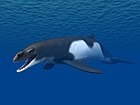Archaebalaenoptera

| Archaebalaenoptera Temporal range: | |
|---|---|
 | |
| Skull | |
| Scientific classification | |
| Domain: | Eukaryota |
| Kingdom: | Animalia |
| Phylum: | Chordata |
| Class: | Mammalia |
| Order: | Artiodactyla |
| Infraorder: | Cetacea |
| Family: | Balaenopteridae |
| Genus: | †Archaebalaenoptera Bisconti, 2007 |
| Species | |
Archaebalaenoptera is a genus of extinct rorqual known from late Miocene to Pliocene-age marine deposits of the Netherlands, Northern Italy, and Peru.
Classification
[edit]The type species, A. castriarquati, was discovered in 1983 from the sediments of the late Pliocene (Piacenzian) Castell’Arquato Formation in northern Italy.[2] A cladistic analysis of Balaenopteridae recovered Archaebalaenoptera as one of if not the most primitive rorqual.[2] A second Archaebalaenoptera species, A. liesselensis, is known from the late Miocene (late Tortonian) Breda Formation near Liessel, in the Netherlands while an unnamed species is known from Peru. A. liesselensis differs from the type species and the unnamed Peruvian species in being larger.[3]

Paleobiology
[edit]The primitive morphology of the jaw suggests that Archaebalaenoptera probably was not capable of ram feeding like living rorquals and humpback whales.[2]
References
[edit]- ^ Bisconti M, Ochoa D, Urbina M, Salas-Gismondi R, 2022. Archaebalaenoptera eusebioi, a new rorqual from the late Miocene of Peru (Cetacea, Mysticeti, Balaenopteridae) and its impact in reconstructing body size evolution, ecomorphology and palaeobiogeography of Balaenopteridae. Journal of Systematic Palaeontology https://doi.org/10.1080/14772019.2021.2017363
- ^ a b c M. Bisconti. 2007. A new basal balaenopterid whale from the Pliocene of northern Italy. Palaeontology 50(5):1103-1122
- ^ Bisconti M, Munsterman DK, Fraaije RHB, Bosselaers MEJ, Post K. 2020. A new species of rorqual whale (Cetacea, Mysticeti, Balaenopteridae) from the Late Miocene of the Southern North Sea Basin and the role of the North Atlantic in the paleobiogeography of Archaebalaenoptera. PeerJ 8:e8315 https://doi.org/10.7717/peerj.8315



